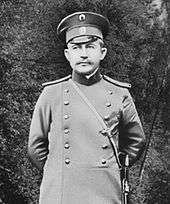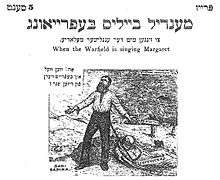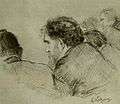Menahem Mendel Beilis

| Part of a series on |
| Antisemitism |
|---|
 Part of Jewish history |
|
Antisemitism on the Web |
|
Opposition |
|
|
Menahem Mendel Beilis (sometimes spelled Beiliss;[1] Russian: Менахем Мендель Бейлис, Yiddish: מנחם מענדל בייליס; 1874 – 7 July 1934) was a Russian Jew accused of ritual murder in Kiev in the Russian Empire in a notorious 1913 trial, known as the "Beilis trial" or "Beilis affair". The process sparked international criticism of the antisemitic policies of the Russian Empire. Beilis's story was the basis for Bernard Malamud's novel The Fixer, which won both the Pulitzer Prize and the National Book Award.
Background
Menahem Mendel Beilis was born into a hassidic family, but was indifferent to religion, and worked regularly on the Sabbath and at least some of the Holidays. In 1911 he was an ex-soldier and the father of five children, employed as a superintendent at the Zaitsev brick factory in Kiev.
Murder of Andrei Yushchinsky
On March 12, 1911 (under the old Russian calendar), the 13-year-old Ukrainian boy Andrei Yushchinsky disappeared on his way to school. Eight days later his mutilated body was discovered in a cave near the Zaitsev brick factory. Beilis was arrested on July 21, 1911, after a lamplighter testified that the boy had been kidnapped by a Jew. A report submitted to the Tsar by the judiciary regarded Beilis as the murderer of Yushchinsky.
Beilis spent more than two years in prison awaiting trial. Meanwhile, an antisemitic campaign was launched in the Russian press against the Jewish community, with accusations of the ritual murder. Among those who wrote or spoke against false accusations of the Jews were Maxim Gorky, Vladimir Korolenko, Alexander Blok, Alexander Kuprin, Vladimir Vernadsky, Mykhailo Hrushevskyi and Pavel Milyukov.
When Beilis had been in prison for already more than a year, a delegation led by a military officer came to his cell. In what might have been a ploy to get Beilis to incriminate himself or other Jews, the officer informed Beilis that he would soon be freed due to a manifesto pardoning all katorzhniks (convicts at hard labor) on the tercentenary jubilee of the reign of the Romanov dynasty. As related in his memoir, Beilis refused this overture:
- “That manifesto,” said I, “will be for katorzhniks, not for me. I need no manifesto, I need a fair trial.”
- “If you will be ordered to be released, you’ll have to go.”
- “No – even if you open the doors of the prison, and threaten me with shooting, I shall not leave. I shall not go without a trial.”[2]
This is one of many incidents from Beilis’s memoir that Bernard Malamud incorporated in his novel The Fixer.[3]
The trial




During the pre-trial period in 1911–1912 the investigation was conducted by Nikolay Krasovsky (Николай Александрович Красовский), the foremost investigator of the Kiev Police Department. Krasovsky forsook any prospect of promotion and continued his investigation in spite of resistance and sabotage from the circles interested in railroading Beilis; he eventually refused to participate in the alleged falsification of the case and was fired.
Krasovsky continued his investigation privately, assisted by his former colleagues from the Kiev Police Department. They eventually were able to determine the actual killers of Yushchinsky, who were professional criminals: Rudzinsky, Singayevsky, Latyshev, and Vera Cheberyak, whose son Yevgeny was a friend of Yushchinsky's.
On 30–31 May 1912, reports were published in Kiev's newspapers. Immediately after this, Krasovsky was arrested on charges of official misuse committed in 1913 but acquitted by a court.
The Beilis trial took place in Kiev from September 25 through October 28, 1913. The prosecution was composed of the government's best lawyers. Professor Sikorsky of Kiev State University (father of Igor Sikorsky), a medical psychologist, testified as an expert witness for the prosecution that in his opinion it was a case of ritual murder.
Beilis had a strong alibi that resulted, ironically, from his habit of working on the Jewish Sabbath. Yushchinsky was abducted on a Saturday morning, and Beilis was then at work, as confirmed by his Gentile co-workers in trial testimony. Receipt slips for the shipment of bricks, signed by Beilis that morning, were produced in evidence. The prosecution was forced to argue that Beilis could have ducked out for a few minutes, kidnapped Yushchinsky, and then returned to work.[4]
One prosecution witness, presented as a religious expert in Judaic rituals, was a Catholic priest, Justinas Pranaitis from Tashkent, well known for his antisemitic 1892 work Talmud Unmasked. Pranaitis testified that the murder of Yushchinsky was a religious ritual, associating the murder of Yushchinsky with the blood libel, a legend believed by many Russians at the time. One police department official is quoted as saying:
- The course of the trial will depend on how the ignorant jury will perceive arguments of priest Pranaitis, who is sure about the reality of ritual murders. I think, as a priest he is able to talk with peasants and to convince them. As a scientist, who defended a thesis about this question, he will give props to the court and prosecution, though nothing can be guessed in advance yet. I became acquainted with Pranaitis and am firmly convinced that he is the person who knows the problem, about which he will talk, in depth... Everything, then, will depend on which arguments priest Pranaitis will furnish, and he has them, and they're shattering for the Jewry.[5]
Beilis was represented by the most able counsels of the Moscow, St. Petersburg, and Kiev bars: Vasily Maklakov, Oscar Gruzenberg, N. Karabchevsky, A. Zarudny, and D. Grigorovitch-Barsky. Two prominent Russian professors, Troitsky and Kokovtzov, spoke on behalf of the defense in praise of Jewish values and exposed the falsehood of the accusations, while professor of Kiev Theological Seminary Orthodox Christian philosopher Alexander Glagolev affirmed that "the Law of Moses forbids spilling human blood and using any blood in general in food." The well-known and respected Rabbi of Moscow, Rabbi Mazeh, delivered a long, detailed speech quoting passages from the Torah, the Talmud and many other books to conclusively debunk the testimony of the prosecution "experts".[6]
The lamplighter, on whose testimony the indictment of Beilis rested, confessed that he had been confused by the secret police.
Pranaitis' credibility rapidly evaporated when the defense demonstrated his ignorance of some simple Talmudic concepts and definitions, such as hullin,[1] to the point where "many in the audience occasionally laughed out loud when he clearly became confused and couldn't even intelligibly answer some of the questions asked by my lawyer."[6] A Tsarist secret police agent is quoted, reporting on Pranaitis' testimony, as saying:
- Cross-examination of Pranaitis has weakened evidentiary value of his expert opinion, exposing lack of knowledge of texts, insufficient knowledge of Jewish literature. Because of amateurish knowledge and lack of resourcefulness, Pranaitis' expert opinion is of very low value. Professors Troitskij and Kokovtsev, who were interrogated today, gave conclusions which are exceptionally positive for the defence, praising doctrines of the Jewish religion, and not accepting even a possibility of a religious murder by Jews ... Vipper thinks that acquittal is possible.[5]
The prosecution's case was further undermined after it had spent a great deal of effort to link the 13 wounds which Professor Sikorsky had discovered on a part of the murdered boy's body with the importance of the number thirteen in "Jewish ritual," only to have it revealed later that there were actually 14 wounds on that part of the body.[6]
The chief prosecutor A.I. Vipper made supposedly antisemitic statements in his closing address. There are conflicting accounts of the twelve Christian jurors: seven were members of the notorious Union of the Russian People, also known as the Black Hundreds. There was no single representative of the intelligentsia in the jury. However, after deliberating for several hours, the jury acquitted Beilis.
After the trial

The Beilis trial was followed worldwide and the antisemitic policies of the Russian Empire were severely criticized. The Arabic newspaper Filastin published in Jaffa dealt with this trial in several articles.[7] The Beilis case was compared with the Leo Frank case in which an American Jew, manager of a pencil factory in Atlanta, Georgia, was convicted of raping and murdering 13-year-old Mary Phagan, though the actual murderer is now suspected to be James Conley. Leo Frank was lynched after his sentence was commuted to life imprisonment.
After his acquittal, Beilis became an enormous hero and celebrity. One indication of the extent of his fame: "Anyone wanting to see the major stars of New York’s Yiddish stage on Thanksgiving weekend in 1913 had three choices: Mendel Beilis at Jacob Adler’s Dewey Theater, Mendel Beilis at Boris Thomashefsky’s National Theater, or Mendel Beilis at David Kessler’s Second Avenue Theater.”[8]
Due to his great fame and the adulation he received, Beilis could have become wealthy through commercial appearances and the like. Spurning all such offers,[9] he and his family left Russia for Palestine, then a province of the Ottoman Empire.
Beilis had difficulty making ends meet in Palestine, but for years he resisted leaving. When friends and well-wishers pleaded with him to go to America, he would respond: “Before, in Russia, when the word ‘Palestine’ conjured up a waste and barren land, even then I chose to come here in preference to other countries. How much more, then, would I insist on staying here, after I have come to love the land!”[10]
Finally, however, Beilis’s financial situation became too desperate. In 1921 he settled in the United States where in 1925 he self-published an account of his experiences, The Story of My Sufferings. Originally published in Yiddish (1925 and 1931 editions), the book was later translated into English (1926, 1992, and 2011 editions), and also Russian.

Beilis died unexpectedly at a hotel in Saratoga Springs[11] on July 7, 1934 and was buried two days later at the Mount Carmel Cemetery, Glendale, Queens. Leo Frank and Sholem Aleichem are also buried there.[12] Though Beilis’s fame had faded since the trial in 1913, it returned briefly at his death. His funeral was attended by over 4,000 people. The New York Times noted that Beilis’s fellow Jews “always believed that his conduct [in resisting all pressure to implicate himself or other Jews] saved his countrymen from a pogrom.”[13] A history of the Eldridge Street Synagogue, where Beilis’s funeral was held, describes the scene at his funeral as follows: “The crowd could not be contained in the sanctuary. As many as a dozen policemen failed to establish order in the streets.”[14]
Around six months before his death, Beilis was interviewed by the English-language Jewish Daily Bulletin. Asked for “one outstanding impression” of the trial in Kiev, he paid a final tribute to the Russian Gentiles who had helped him to escape the blood libel, such as the detective Krasovsky and the journalist Brazul-Brushkovsky: “There was real heroism, real sacrifice. They knew that by defending me their careers would be ruined, even their very lives would not be safe. But they persisted because they knew I was innocent.”[15]
Controversy over depiction in The Fixer
While Bernard Malamud’s novel The Fixer is based on the life of Mendel Beilis, Malamud transformed Beilis’s character, and that of his wife, in ways that Beilis’s descendants found degrading. The actual Mendel Beilis was “a dignified, respectful, well-liked, fairly religious family man with a faithful wife, Esther, and five children.” Malamud’s protagonist Yakov Bok is “an angry, foul-mouthed, cuckolded, friendless, childless blasphemer.”[16]
When The Fixer was first published, Beilis’s son David Beilis wrote to Malamud, complaining both that Malamud had plagiarized from Beilis’s memoir and that Malamud had debased the memories of Beilis and his wife through the characters of Yakov Bok and Bok’s wife Raisl. Malamud wrote back, attempting to reassure David Beilis that The Fixer “makes no attempt to portray Mendel Beilis or his wife. Yakov and Raisl Bok, I am sure you will agree, in no way resemble your parents.”
Nevertheless, The Fixer has caused two kinds of confusion about Mendel Beilis. Some have credited Malamud for inventing aspects of the story that he took from Beilis’s memoir; others have confused Beilis’s character with that of Malamud’s character Yakov Bok. As the historian Albert Lindemann lamented, “By the late twentieth century, memory of the Beilis case came to be inextricably fused (and confused) with... The Fixer.”[17]
Revival in 2006
In the March 2006 issue (No. 9/160) of the Ukrainian Personnel Plus magazine by the Interregional Academy of Personnel Management (commonly abbreviated MAUP), an article "Murder Is Unveiled, the Murderer Is Unknown?"[18] revives false accusations from the Beilis Trial, stating that the jury recognized the case as ritual murder by persons unknown, even though it found Beilis himself not guilty.[18]
In film and Literature
- Edmund Levin - "A CHILD OF CHRISTIAN BLOOD" Schoken Books 2014[19]
- The Black 107, 1913 film[20]
- The Mystery of the Mendel Beilis Case, 1914[21]
- Delo Beilisa (aka The Beilis Case), 1917 film by Joseph Soiffer[22]
- The Fixer, Malamud's 1966 novel, winner of the Pulitzer Prize and the National Book Award
- The Fixer, 1968 film after the novel,[23]
- Scapegoat on Trial, 2007, Joshua Waletzky[24]
- "Blood Libel in Late Imperial Russia: The Ritual Murder Trial of Mendel Beilis", 2013, Robert Weinberg
 Arrested Beilis
Arrested Beilis Composition of the trial. Second right - the chairman of the Kiev District Court F.A. Boldyrev
Composition of the trial. Second right - the chairman of the Kiev District Court F.A. Boldyrev Jury
Jury Beilis in court
Beilis in court Vladimir Korolenko in the Beilis trial
Vladimir Korolenko in the Beilis trial Prosecutor O.Y.Vipper
Prosecutor O.Y.Vipper Civil prosecutor Alexandr S. Shmakov
Civil prosecutor Alexandr S. Shmakov Civil prosecutor MP Georgy G. Zamyslovsky
Civil prosecutor MP Georgy G. Zamyslovsky Defender Oskar O. Gruzenberg
Defender Oskar O. Gruzenberg Defender Alexandr S. Zarudny
Defender Alexandr S. Zarudny Defender Nikolay P.Karabchevsky
Defender Nikolay P.Karabchevsky Defender Vasily A. Maklakov
Defender Vasily A. Maklakov Professor Ivan A. Sikorsky, expert for prosecution
Professor Ivan A. Sikorsky, expert for prosecution Professor Dmitry K. Kosorotov, expert for prosecution
Professor Dmitry K. Kosorotov, expert for prosecution Father Justinas Pranaitis, expert for prosecution
Father Justinas Pranaitis, expert for prosecution Professor Ivan G. Troitsky, expert for defence
Professor Ivan G. Troitsky, expert for defence Rabbi Yakov Mazeh, expert for defence
Rabbi Yakov Mazeh, expert for defence Professor Alexander A. Glagolev, expert for defence
Professor Alexander A. Glagolev, expert for defence Professor Pavel K. Kokovtsov, expert for defence
Professor Pavel K. Kokovtsov, expert for defence Professor Vladimir M. Bekhterev, expert for defence
Professor Vladimir M. Bekhterev, expert for defence
See also
- History of the Jews in Russia and Soviet Union
- Antisemitism in Ukraine
- Dreyfus affair
- The Fixer (Malamud novel)
- Leo Frank
References
- 1 2 Blood Accusation: The Strange History of the Beiliss Case, Samuel, Maurice, Alfred A. Knopf, 1966.
- ↑ Beilis, Mendel. Blood Libel: The Life and Memory of Mendel Beilis, ed. Jay Beilis et al. (2011), p. 64.
- ↑ Malamud, Bernard. The Fixer (1966), p. 294.
- ↑ Samuel, Blood Accusation
- 1 2 "''Царская Россия и дело Бейлиса'', Tager, A., Moscow, 1934". Ldn-knigi.lib.ru. Retrieved 2013-12-05.
- 1 2 3 Scapegoat on Trial: The Story of Mendel Beilis – The Autobiography of Mendel Beilis the Defendant in the Notorious 1912 Blood Libel in Kiev, Beilis, Mendel, Introd. & Ed. By Shari Schwartz, CIS, New York, 1992, ISBN 1-56062-166-4
- ↑ Beška, Emanuel. ""The Disgrace of the Twentieth Century": The Beilis Affair in Filastin Newspaper.". In Jerusalem Quarterly, 2016, Number 66, pp. 99-108. Retrieved 2016-08-17.
- ↑ Berkowitz, Joel, “The ‘Mendel Beilis’ Epidemic on the Yiddish Stage,” Jewish Social Studies 8, no. 1 (Fall, 2001), p. 199
- ↑ “Mendel Beilis Coming,” New York Times, January 25, 1921
- ↑ Beilis, Mendel. Blood Libel: The Life and Memory of Mendel Beilis, ed. Jay Beilis et al. (2011), p. 200.
- ↑ Archived June 17, 2010, at the Wayback Machine.
- ↑ Read English translation of the epitaph on Beilis' footstone.
- ↑ “Beiliss Funeral Attended by 4,000,” New York Times, July 10, 1934.
- ↑ Annie Polland and Bill Moyers, Landmark of the Spirit: The Eldridge Street Synagogue (2008), p. 128
- ↑ Beilis, Mendel. Blood Libel: The Life and Memory of Mendel Beilis, ed. Jay Beilis et al. (2011), p. 285
- ↑ Beilis, Mendel. Blood Libel: The Life and Memory of Mendel Beilis, ed. Jay Beilis et al. (2011), p. 229
- ↑ Lindemann, Albert S., “Beilis Case,” in Antisemitism: A Historical Encyclopedia of Prejudice and Persecution, ed. Richard S. Levy (2005), p. 63
- 1 2 "То есть изуверское убийство было совершено с ритуальной целью, но не Бейлисом, а кем-то другим. Кем?" ВБИВСТВО РОЗКРИТО. ВБИВЦЯ НЕ ВІДОМИЙ?, Yaroslav Oros
- ↑ http://www.edmundlevin.com/
- ↑ "The Jew in American Cinema", Erens Patricia, Patricia Erens, p59-
- ↑ "...the trumped-up charges of ritual murder...", Evening Post, 17 June 1914, Page 3
- ↑ http://www.imdb.com/title/tt0218142/
- ↑ http://www.imdb.com/title/tt0062977/
- ↑ Scapegoat on Trial (2007), IMDB
- ISBN 0-87668-179-8 The Beilis Transcripts. The Anti-Semitic Trial that Shook the World. by Ezekiel Leikin
- ISBN 5-7349-0016-8 The Beilis Case. Modern Research and Documents.
External links
| Wikimedia Commons has media related to Beilis Affair. |
- Chabad article on Beilis case
- A Government Blood Libel: The Beilis Affair (Beyond the Pale – friends-partners.org)
- (Russian) Materials about Beilis Affair
- (Russian) Speech of defense lawyer V.A. Maklakov later issued as a pamphlet
- (Russian) Articles and Call to the Russian Society by Vladimir Korolenko
- (Russian) Stenographic report from the trial. Volumes 1–3
- (Russian) Бейлис, Менахем Мендель in The Shorter Jewish Encyclopaedia, Jerusalem. 1976–2005
- (Russian) Beilis affair: truth and myth by Feliks Levitas, Mikhail Frenkel (Jewish Observer, Jewish Confederation of Ukraine) April 12, 2006